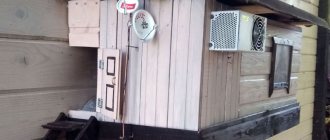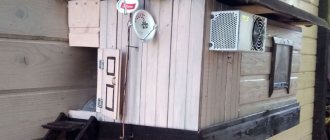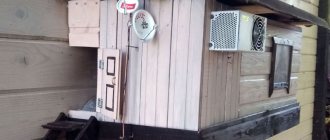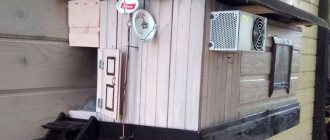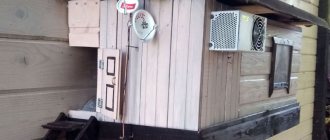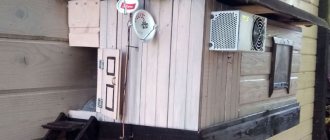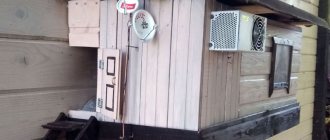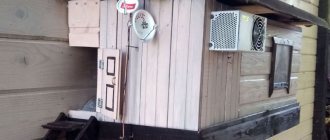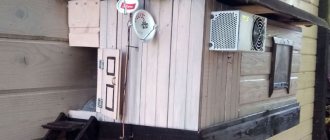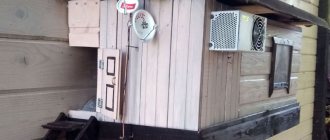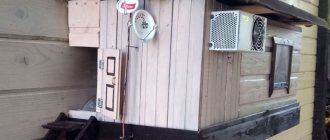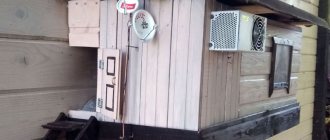Another homemade product for those who are bored at home
I needed a couple of antennas for digital, in places with “not the best reception”... I went shopping (this was before self-isolation - if it’s relatively budget-friendly, then it’s complete G. The more expensive one looks decent, but how it works is questionable.
- if it’s relatively budget-friendly, then it’s complete G. The more expensive one looks decent, but how it works is questionable.
I decided to make something homemade. It was somehow awkward to “twist” an antenna from a piece of cable (although rumor has it it works) - I wanted something simple, but more decent and advanced
In fact, the one I made is not radically more complicated, but somehow more “solid” or something. And the results of its testing were very encouraging, so I decided to sketch out a short description of what and how, in case someone else finds it useful 
... even if my street cats have a “normal” antenna on their house, what can you do without an antenna?!
The wire is not all finished yet, now we’ll assemble something!

In the places described, I previously used home-made broadband log-periodic antennas, probably since the “beginning of perestroika.” They worked well in analog and not only on UHF, but “for some reason, digital was too tough for them.” I didn’t really delve into the essence of the reasons, I removed them and began to think about what to replace them with. Here is one of them, waiting for a place in the trash
They worked well in analog and not only on UHF, but “for some reason, digital was too tough for them.” I didn’t really delve into the essence of the reasons, I removed them and began to think about what to replace them with. Here is one of them, waiting for a place in the trash
A little history
In the early 60s of the last century, our compatriot Kharchenko K.P. developed a simple flat zigzag antenna with good characteristics.
Copyright certificate No. 138277 for an invention called “Band directional antenna” was issued to Konstantin Pavlovich Kharchenko in 1961 (according to his application dated June 16, 1960). In the same year, materials were published in the magazine “Radio” for repetition by radio amateurs.
The antenna is not critical to materials and dimensions during manufacturing, has a simple good match with the reduction cable, and it successfully combines multiple elements of a common-mode antenna array with a single feed point.
Examples of some country antennas
Crow
This inexpensive antenna for the garden gives good results. If you plan to receive only digital television with this antenna, then its two long side “whiskers” can be unscrewed.
Wave channel
They give good results, especially for remote signal reception when it is quite weak.
Polish
Many TV viewers use the “Polish” antenna - a grid and four rows of antennae. It doesn’t matter where it was made, they used to call it “Polish”, and sometimes “mesh”. Very often it does not demonstrate the best characteristics for receiving a digital signal.
You may be interested in: Which cable is better: seven practical ways to check quality
In general, for receiving DVB T2 digital television at the dacha , it is very sensitive. If the reception of the digital signal on it in your area turns out to be normal, then you are just lucky. The amplifier of this antenna can be powered by 5 Volts, which can be taken from a digital tuner, and then there is no need to use an additional power supply.
Zigzag
Very few are represented in the retail network; they are familiar only to radio amateurs. They are poorly protected from radio interference, although they have a fairly uniform frequency response.
Indoor
Only in very rare cases does an indoor antenna show good results for digital television. Even if you paid dearly for it, the result may be zero.
If you only want an indoor antenna as an on-air antenna for your dacha, you may be “advised” to buy it more expensive and “better”. But if you hope that she will start giving you a wonderful signal in your room, then this hope is in vain. If there is a bad signal in the house, no antenna will help. External - this is the solution to the problem if there is no reception in the room.
Theory and calculations
The described antenna, in theory, has a horizontal “figure-of-eight” radiation pattern and a relatively high gain, which can be further increased by using a reflector/reflector.
To obtain maximum gain on all channels, it is necessary to make an antenna approximately in the middle of the range between the multiplexes used.
Finding (for calculations) the frequencies of multiplexes used in your region is easy,
for example, a request like “dvb-t2 channel frequencies” + “Krasnodar”
I found something like this:
The middle, between “my” two multiplexes, is 700 MHz - we will calculate the antenna at this frequency.
As a basis for calculating the dimensions of the antenna, we take the drawing of its author
Calculate the wavelength: λ = 300 / f [m]
300/700 = 0.428m, approximately 43cm length of each side of the rhombus
λ/4
=43/4= 10.75
The total length of the material we need (11cm*8=88cm) is less than a meter. The distance between the reduction contacts, where we will solder the cable, is 10-12mm (the standard value for this antenna for frequencies below 900 MHz).
I will make a simple antenna, without a reflector, however, to further increase the gain of this antenna, it is quite possible to install it behind it
for example, from a metal mesh/grill, foil material or simply a metal plate. Its dimensions should be approximately 20 percent larger than the dimensions of the antenna and it should be located at a distance of ƛmax/7. For my case: wavelength (channel 39) 300/618, it turns out...49/7= that is, about 7cm
For those who are too lazy to do the calculations themselves
— you can use an online calculator, the results will differ only slightly from those I received. Here, for example, this one - here you immediately enter the frequencies of two multiplexes and get the dimensions of the antenna (without a reflector) Or another option, with a reflector - I really want to note that in the second option a slightly different calculation option is used, different from the author’s. An antenna with angles other than 90° is assumed and the reflector distance is calculated as λ/8
To make the antenna sheet, it is recommended to use aluminum or copper (copper is easily soldered) with a diameter of 3 mm and higher - the larger the diameter, the more broadband the antenna is. You can use tubes; the thickness of the walls is not important, since only the surface of the material is used (in fact, you can wrap any dielectric with foil to obtain the required material). However, in my opinion, the easiest way is to buy a meter of large-gauge copper wire at an electrical supply store.
TOP 5 outdoor TV antennas
Let's now look at the rating of top outdoor antennas for outdoor installation. The devices from our top have good technical characteristics, and their choice is approved by many Russians.
Locus Zenit-14AF
Locus Zenit-14AF
A very cheap, but high-quality antenna for digital TV, made on an aluminum base. It has its own amplifier of 15-20 decibels. Easy to install and holds up well in the wind. The kit includes a long cord of 5 meters, which is very convenient. The main disadvantage is that it is not suitable for small towns and villages, since the gain level is quite modest. Price – 700 rubles.
Hyundai H-TAE220
Hyundai H-TAE220
Let us note right away that the antenna does not have its own amplifier, so in small settlements and on the outskirts of cities its use will be ineffective. In terms of other technical indicators, it is a quite good antenna for digital television. The main advantages are high stability, stable communication reception, simple use (no need to connect to the mains). Another plus is the very low price (600 rubles).
Locus Meridian 07AF Turbo
The main feature of this device with an amplifier is its good filtering of the useful signal (according to the manufacturers, it is 3 dB). The device is made of aluminum, so installing such an antenna is not difficult. The gain is not very good, but decent - 30 decibels. If desired, you can hang it on the wall, although in this case you will have to tinker (the mounting bracket is not included in the package). The average price is 800 rubles.
LUMAX DA2501A
LUMAX DA2501A
Another outdoor antenna with a medium power amplifier (30 decibels). The kit includes a long five-meter cable, which is very convenient if the TV is located far from the antenna. The device is lightweight, easy to install, and maintains high signal quality even in bad weather. However, unlike the same Locus, this model with an amplifier does not include a filter to separate the useful signal from the noise, which somewhat spoils the impression. Price – 800 rubles.
HARPER ADVB-2440
A very non-standard model with an amplifier in design and contents, which has already become a favorite of many Russians. Thanks to its unusual shape, the device has an ideal viewing angle of 360 degrees. Therefore, you can hang it in any position - it will still clearly catch digital TV. The gain here is average (only 30 decibels), although it will do for urban outskirts and small towns. Major disadvantages are a very short cable (only 1.5 meters), a fairly high price (1600 rubles).
Antenna assembly
Let's remove the insulation from a piece of wire one meter long.
I got a wire with a diameter of 4.5mm
The tools you will need are a vice and a hammer. Measure approximately 11cm each and bend at an angle of 90°
The end result is to get such a “geometric” figure 
We cut off the excess and solder the ends. It should look something like this...
Solder the cable as shown in the photo.
We lay the cable along one side of the square and secure it with clamps. This arrangement of the cable is necessary for its coordination (there are different opinions, not everyone agrees with this statement).
When using a reflector, the antenna sheet at the extreme points of the squares can also be secured using metal stands, for example, soldered onto the remains of the same copper wire - there are points with zero potential (highlighted in green). In other places, fastening is allowed only through a dielectric.
Tests
And finally, a performance check and a rough
assessment of the quality of the resulting antenna.
In fact, everything is simple with the test - turn it on, it works! And to evaluate whether the game was “worth the candle,” let’s compare the parameters of the received signal from the manufactured antenna with the one I’m already using at the dacha, with a declared gain of 11dBi
And to evaluate whether the game was “worth the candle,” let’s compare the parameters of the received signal from the manufactured antenna with the one I’m already using at the dacha, with a declared gain of 11dBi
The antenna is installed in the attic of a country house, at a distance of approximately 16 km from the tower.
Signal level: factory stationary antenna on the left / homemade on the right
At first glance, the difference is only 1% (95 versus 94) - but this is not a completely correct comparison, since my external antenna is connected through a splitter, which further weakens the signal.
How to choose the right indoor television antennas?
When choosing an indoor antenna for digital TV, you should pay attention to:
- The ability to receive decimeter waves (UHF), that is, digital television, is a prerequisite.
- The ability to receive a DVB-TV2 signal, that is, the digital signal standard used by domestic “digital” broadcasts.
- Power source type – active or passive. The passive device is powered by a TV or set-top box, the active antenna is connected to a separate outlet and guarantees a more powerful signal.
- A signal booster is an important consideration if the location is remote from the tower. The presence of an amplifier is mandatory for country houses, dachas or the outskirts of the city.
- Amplifier power - if the location is remote from the television center, you need at least 30-40 dB.
- Reception of FM frequencies – makes it possible to listen to digital radio.
Before you buy an indoor antenna for receiving a digital TV signal, you should check the digital TV coverage area or determine the distance of the television center from your area of residence on the official RTRS website. This will determine whether it is necessary to have a built-in signal reception amplifier. And this review with reviews and rating characteristics will help answer the question of which indoor antenna is best to buy for a TV.
Assessing the performance of the antenna
Let's try to make a more correct comparison by connecting through the splitter input.
Well, in addition, for clarity, let’s add the number of participants List of antennas taking part in the comparison:
1. External antenna Funke BM 4551 external long-range,
declared gain, from some sources (bought at Yulmart), up to 16dB
2. There is an old UHF loop antenna, from TV Electronica 313d, I must say, despite its simplicity, it’s a very good antenna, that’s why it’s been preserved 
3. I went to the store and bought for comparison in the review one of the cheapest, such as a symmetrical vibrator (100% the most purchased by pensioners, due to the low price).
I will carry out all “measurements” at one point, located as close as possible to the external antenna - its location was experimentally selected based on the maximum signal, so we can say that the conditions are approximately the same
So, we have already seen the signal level from the external antenna at 95% (at the time of current measurements it showed 94%), we take it as a standard. All comparisons are made by connecting antennas to the input on the splitter, to which an external antenna is usually connected.
Loop antenna, from Electronics 82% on 39 multiplex and 66% on 60
Budget with “horns” - 62%/38% (on the verge of losing the broadcast)
- 62%/38% (on the verge of losing the broadcast)
Double square - 92% on both multiplexes, about a couple of percent less than the external one
Out of curiosity, I decided to check the work of the reflector, which is easy to make from any metal mesh, plate or even foil... It REALLY works noticeably! The level rose to 96%!, which is even higher than the stationary one, with a declared gain of 11dB.
The most interesting thing is the object that I used as a reflector! 
There was no foil in the house; the only thing available with a metal surface of the required size was... a laptop cover (I have a metal case). But the main thing is the result! It’s clear that I’m not going to “tie” the laptop to the antenna, and its amplification is enough for me without a reflector
Types of antennas for digital TV
What is needed for reliable and high-quality digital signal reception? Of course, an antenna, but which one? It doesn’t matter where exactly your home is located, the issue of choosing equipment should be taken as responsibly as possible, because the complexity of setting up TV channels will depend on this.
Indoor models are an option for users who are in close proximity to television towers. There are several types of digital antennas:
- active – equipped with an additional signal amplifier and operate from a 220V network. This option is needed if you are in an area of uncertain reception;
- passive - do not contain additional devices, they receive a signal only due to their area and shape. Numbers are used in the area of reliable reception.
Special digital TV antennas are a marketing ploy, since in principle they do not exist, as well as cables and amplifiers designed for T2. This is an invention of manufacturers, which allows them to sell ordinary products more efficiently.
In other words, when connecting digitally, you will use the most ordinary antenna, as is the case with analog TV. A standard amplifier and coaxial cable are also purchased. All this equipment will be suitable for the new standard.
Naturally, you still need to take into account the technical characteristics of the TV antenna. For example, if you are far from the signal transmitter, then be sure to buy an active broadband model so that all channels are shown in high quality.
For best results, buy a multi-director model, position it at maximum height and point it directly towards the TV tower. Practice confirms that long television antennas with an impressive number of crossbars show the most effective results.
Conclusion:
I can confidently recommend repeating it!
Simple, “cheap and tasty”... One of the simplest, indoor antenna mounts... with ordinary suction cups - if you’re lucky with the direction to the television center
The next antenna "recommended for repetition" is... log periodic
“Crazy hands” were with you. Good luck and good mood to everyone! ☕
Good luck and good mood to everyone! ☕
